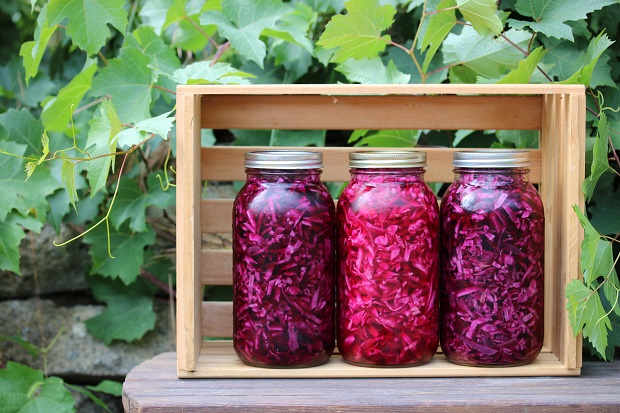- Eating sauerkraut helps protect you from breast cancer.When cabbage is fermented as it is in making sauerkraut, its nutrients, known as glucosinolates, transform into the powerhouse anticancer nutrients isothiocyanates. Researchers have found that isothiocyanates balance excessive hormone production linked to breast cancer and even suppress tumor growth.
- Kimchi is the medicine of the future.Scientists have identified a whopping 970 different probiotic species in kimchi, many of which offer powerful immune-boosting effects. Some of these unique probiotics are proven to kill superbugs even when our most potent medicines fail! The Journal of Medicinal Food found that kimchi’s additional health properties include anticancer properties, anti-obesity benefits, anticonstipation, colorectal health promotion, cholesterol reduction, fibrolytic effect (a process that prevents blood clots from growing), antioxidative and anti-aging properties, brain health promotion, immune promotion, and skin health promotion.
- Regular consumption of miso fights at least five different types of cancer.Research published in multiple medical journals, including the International Journal of Oncology, found that miso consumption prevents and even effectively treats lung, liver, breast, colon, and liver cancers.
- Eating yogurt can reduce four markers essential for preventing diabetes and heart disease.Research published in the journal Nutrition demonstrated that yogurt cultured with the probiotic L. plantarum improved cholesterol levels, blood sugar balance, and homocysteine levels in women with metabolic syndrome. Metabolic syndrome is a cluster of four symptoms, and when they occur together, they increase a person’s risk of diabetes as well as heart disease and stroke. So reducing these markers bodes well for long-term health.
- Eating certain fermented foods can alleviate seasonal allergies.Fermented plums contain beneficial yeasts known as Saccharomyces cerevisiae that have been linked to reducing allergies, congestion, and sinusitis. But why pop expensive supplements when you can reap these benefits and enjoy my Cultured Plum Chutney?
- Eating fermented foods can give your brain a boost.Exciting new research published in the Journal of Physiological Anthropology found that intentionally boosting beneficial microbes by adding fermented foods to the diet could directly activate neural pathways between the gut and the brain and may boost brain health and prevent depression.
- Eating nondairy yogurt can improve bone density and reduce the risk of osteoporosis.Research published in the International Journal of Food Science and Nutrition and multiple other journals found a direct link between dairy-free yogurt consumption and bone health.
- Drinking probiotic-rich kefir helps protect against cancer and even effectively treats the disease.Kefir contains a probiotic called Lactobacillus kefiri P-IF, which is effective against leukemia even when multiple cancer drugs fail.
- Eating fermented soy, known as miso, can prevent radiation injury.It’s not just an urban myth: medical research conducted in Hiroshima found that eating fermented soy protects against the damaging effects of radiation — a growing concern in our modern society.
- Fermented foods are the missing link when it comes to effortless and permanent weight loss.In manystudies the intestines of overweight and obese people were found to differ from those of lean people. Research published in the medical journal Beneficial Microbes found that obese and overweight people tend to have a higher ratio of harmful microbes to beneficial ones. The best way to boost beneficial microbes to benefit from their slimming properties is to enjoy fermented foods that contain live cultures on a regular basis.
These health benefits are just the tip of the iceberg. New studies are being released on an almost daily basis, demonstrating the health benefits of incorporating more probiotics and probiotic-rich foods into the diet.
Purple Sauerkraut
This brilliant-colored sauerkraut is as delicious as it is beautiful. It derives its lovely hue from the naturally occurring pigments in purple cabbage, known as proanthocyanidins. During the fermentation process this color transfers from one side of the cabbage to the whole leaf. It’s a colorful addition to any meal and is particularly good served on a bed of plain brown rice or noodles.
Makes approximate 2 to 2½ quarts
1 small head green cabbage, shredded
1 small head purple cabbage, shredded
2 apples, thinly sliced
3 tablespoons unrefined fine sea salt or 6 tablespoons unrefined coarse sea salt
1 quart (or liter) filtered water
In a large, clean crock or a large glass or ceramic bowl, layer the green cabbage, purple cabbage, and apples until the mixture is approximately 1 to 2 inches from the top of the crock or bowl or you have used all the ingredients. Push down the cabbage and apple mixture with your clean fist or a wooden spoon to make it more compact and to release the juices as you go.
In a pitcher or large measuring cup, dissolve the salt in the water, stirring if necessary to encourage the salt to dissolve. Pour the saltwater over the cabbage-apple mixture until the ingredients are submerged, leaving a couple of inches of room at the top for the ingredients to expand.
Place a plate that fits inside the crock or bowl over the cabbage-apple-water mixture, and weigh it down with food-safe weights or a bowl or jar of water, making sure the vegetables remain submerged under the brine as they ferment. (Ideally, choose the biggest plate possible to fit inside the crock and provide the greatest amount of surface coverage to prevent cabbage pieces from floating to the top of the crock.) Cover with a lid or a cloth, and allow it to ferment for at least two weeks, checking periodically to ensure that the cabbage-apple mixture is still submerged below the water line. After two weeks the sauerkraut will still be fairly crunchy; if you like a more traditional sauerkraut, allow it to ferment longer to soften the cabbage further.
If any mold forms on the surface, simply scoop it out. It will not spoil the sauerkraut unless it gets deeper inside the crock. It may form where the mixture meets the air, but it rarely forms deeper inside the crock.
After two weeks, or longer if you prefer a tangier sauerkraut, dish out the sauerkraut into jars or a bowl, cover, and place in the fridge, where it will usually last for at least a year.
© Photo Credit: Michelle Schoffro Cook
Excerpted from the book The Cultured Cook: Delicious Fermented Foods with Probiotics to Knock Out Inflammation, Boost Gut Health, Lose Weight & Extend Your Life. Copyright © 2017 by Michelle Schoffro Cook. Printed with permission from New World Library. www.newworldlibrary.com



